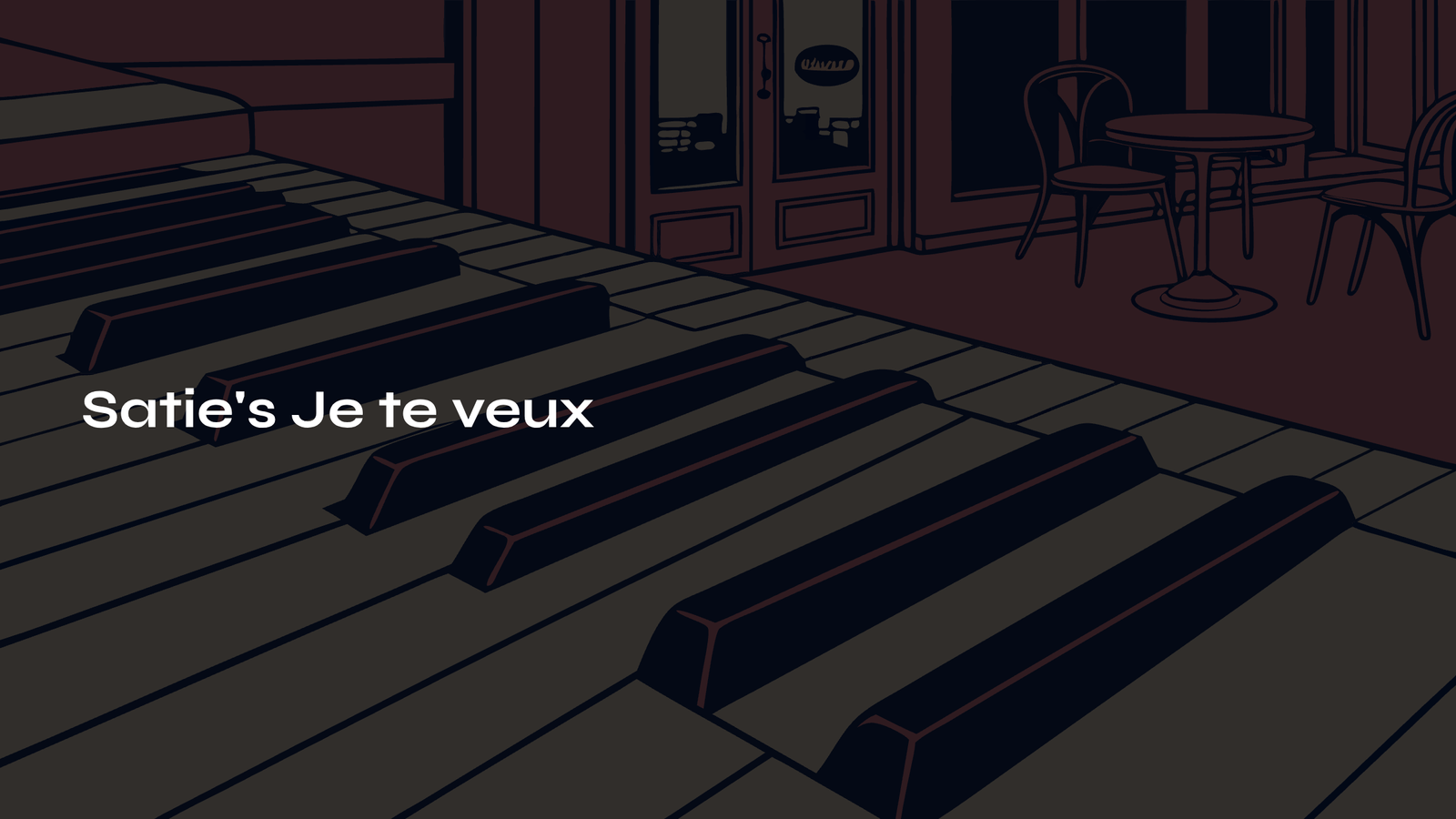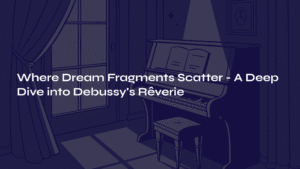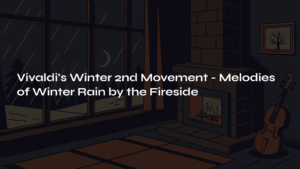Table of Contents
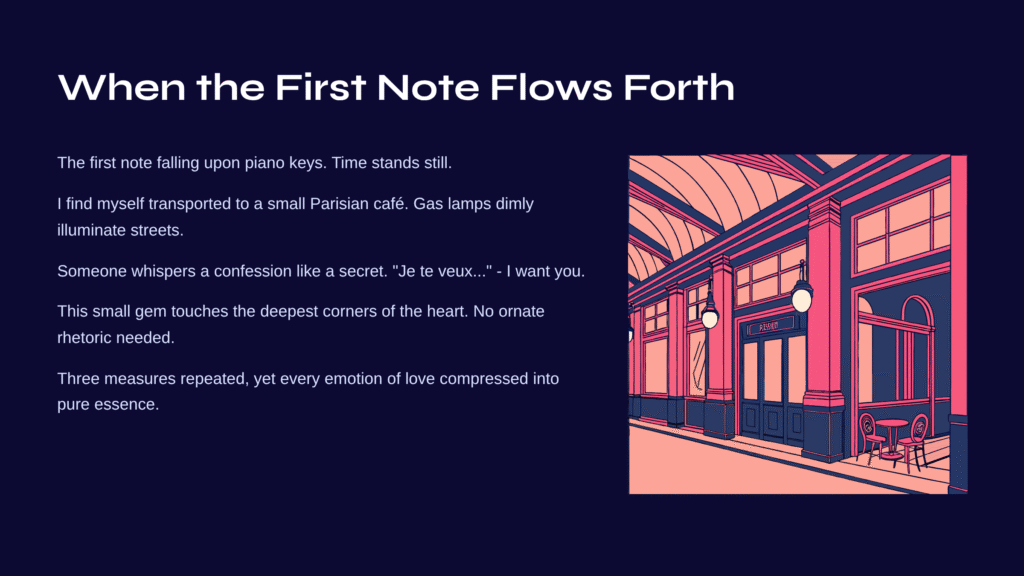
When the first note flows forth, time stands still
The first note falling upon piano keys. In that moment, I find myself transported to a small Parisian café of the 19th century. Outside the window, gas lamps dimly illuminate the streets, and somewhere, someone whispers a confession like a secret. “Je te veux…” – I want you.
This small gem of Erik Satie’s touches the deepest corners of the heart without any ornate rhetoric. Though merely three measures repeated, within them lies every emotion of love compressed into pure essence. Perhaps you too, when first hearing this piece, felt as though you were opening an old diary filled with forgotten memories?
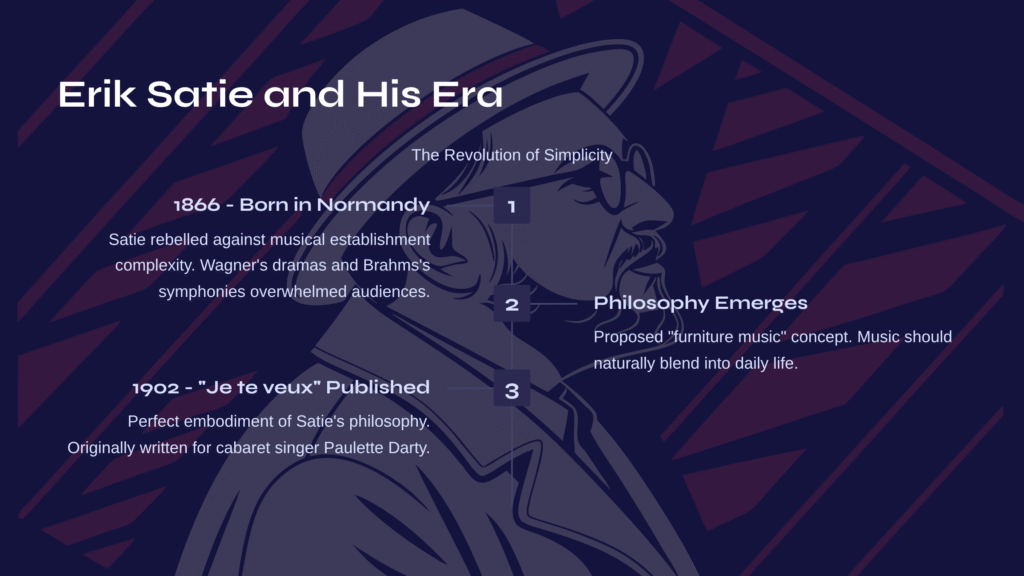
Erik Satie and His Era – The Revolution of Simplicity
Born in Normandy in 1866, Erik Satie was a composer who rebelled against the complexity of his era’s musical establishment. While Wagner’s monumental music dramas swept across Europe and Brahms’s profound symphonies overwhelmed audiences, Satie chose the opposite path. He proposed the concept of “furniture music (musique d’ameublement),” arguing that music should naturally blend into daily life.
“Je te veux,” published in 1902, represents the perfect embodiment of Satie’s philosophy. Originally written as a chanson for cabaret singer Paulette Darty, it later gained wider recognition when arranged as a piano solo. The elegant 3/4 waltz rhythm evokes the ballrooms of Parisian high society, yet Satie’s characteristic brevity lends it a unique charm all its own.
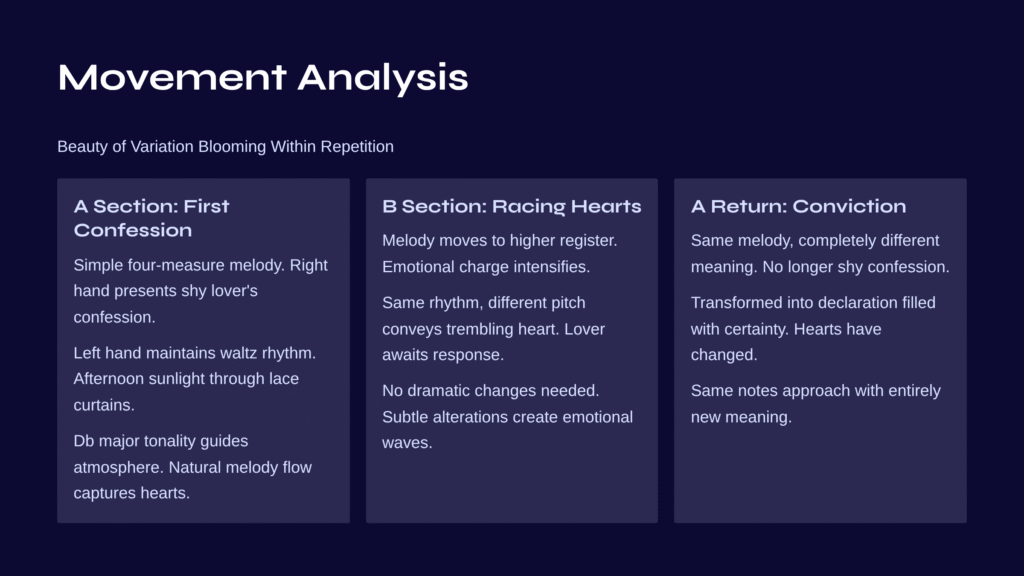
Movement Analysis – Beauty of Variation Blooming Within Repetition
A Section: The Tremor of First Confession
The piece begins with a simple four-measure melody. This melody, presented by the piano’s right hand, feels like a shy lover making their first confession. The left hand’s waltz accompaniment maintains a regular 3/4 rhythm while never overwhelming the main melody. Listening to this section, I always envision afternoon sunlight filtering through lace curtains.
Harmonically, the warm tonality of Db major guides the overall atmosphere. Yet Satie avoids complex harmonic progressions here, focusing instead on the natural flow of melody. This melody, flowing like spoken words, captures the listener’s heart without any artificial virtuosity.
B Section: The Moment When Hearts Race
In the middle section, the melody moves to a slightly higher register, intensifying the emotional charge. While maintaining the same rhythmic pattern, this change in pitch alone conveys the trembling of the heart more vividly. In this passage, I imagine a lover’s heart racing while awaiting their beloved’s response.
What’s fascinating is that even here, Satie employs no dramatic dynamic changes or complex rhythmic variations. Instead, he creates emotional waves through subtle pitch alterations and harmonic color adjustments alone. This restrained expression is perhaps the true essence of Satie’s musical charm.
A Section Return: Confession with Conviction
The thematic melody that returns at the end remains identical to the opening, yet sounds completely different. No longer a shy confession, it has transformed into a declaration of love filled with certainty. Though the same notes, our hearts have already changed, and so the same melody approaches us with entirely new meaning.
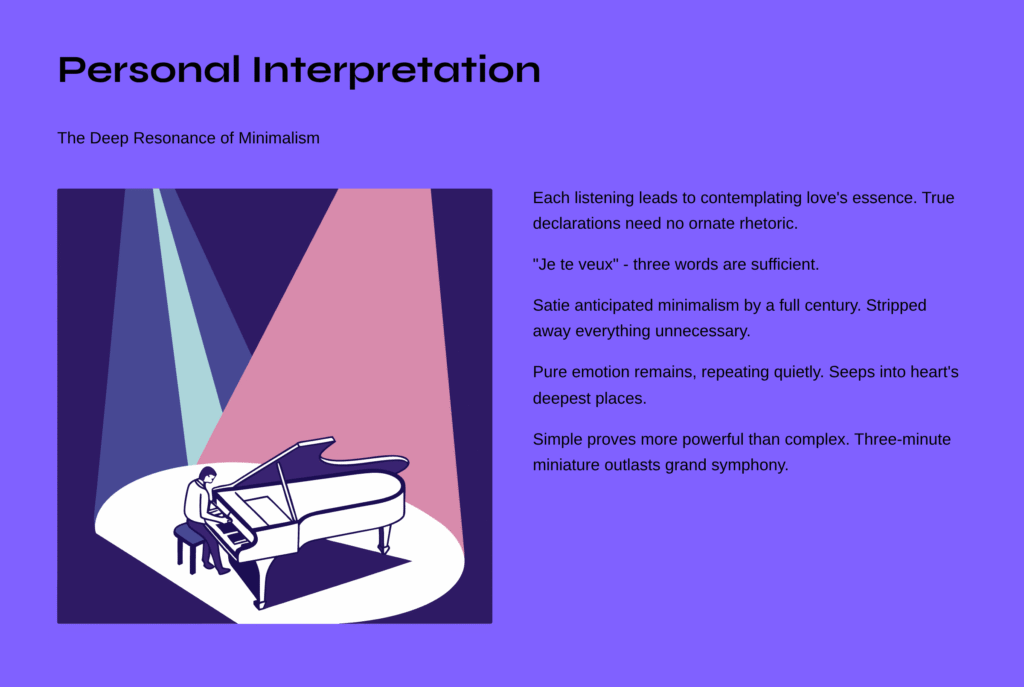
Personal Interpretation – The Deep Resonance of Minimalism
Each time I hear this piece, I’m led to contemplate the essence of love itself. That true declarations of love require neither ornate rhetoric nor complex expression. That “Je te veux” – these three words alone – are sufficient.
Satie’s music anticipated our era’s minimalism by a full century. Having stripped away everything unnecessary, what remains is pure emotion alone. This emotion repeats and repeats again, quietly seeping into the deepest places of our hearts.
Sometimes the simple proves more powerful than the complex. A three-minute miniature can linger longer in memory than a grand symphony. Listening to this piece, I wonder if love, music, and indeed life itself ultimately find their truest beauty within simplicity.
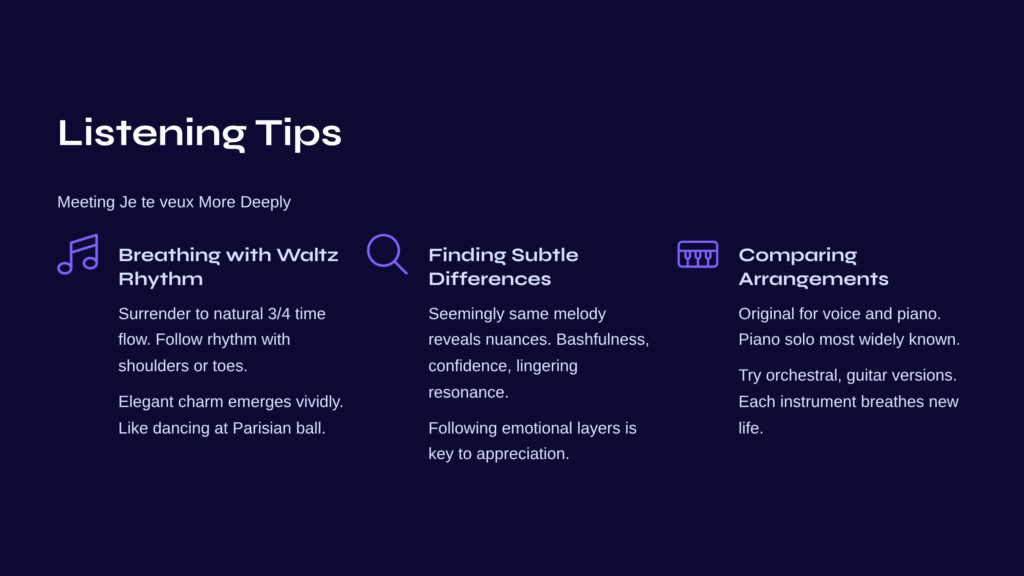
Listening Tips – Meeting Je te veux More Deeply
Breathing with the Waltz Rhythm
When listening to this piece, surrender yourself to the natural flow of 3/4 time. Gently follow the waltz rhythm – from strong beat to weak beats – with your shoulders or toes, and the piece’s elegant charm will emerge more vividly. As if dancing at a 19th-century Parisian ball.
Finding Subtle Differences Within Repetition
Though seemingly repetitions of the same melody, careful listening reveals subtle nuances in each return. The bashfulness of the first A section, the confidence of the second repetition, the lingering resonance of the final return. Following these emotional layers without missing them is key to appreciating this piece.
Comparing Various Arrangements
While the original was written for voice and piano, the piano solo version is most widely known. Beyond this, try comparing orchestral arrangements, guitar transcriptions, and other versions. You’ll experience how each instrument’s unique timbre breathes new life into the composition.
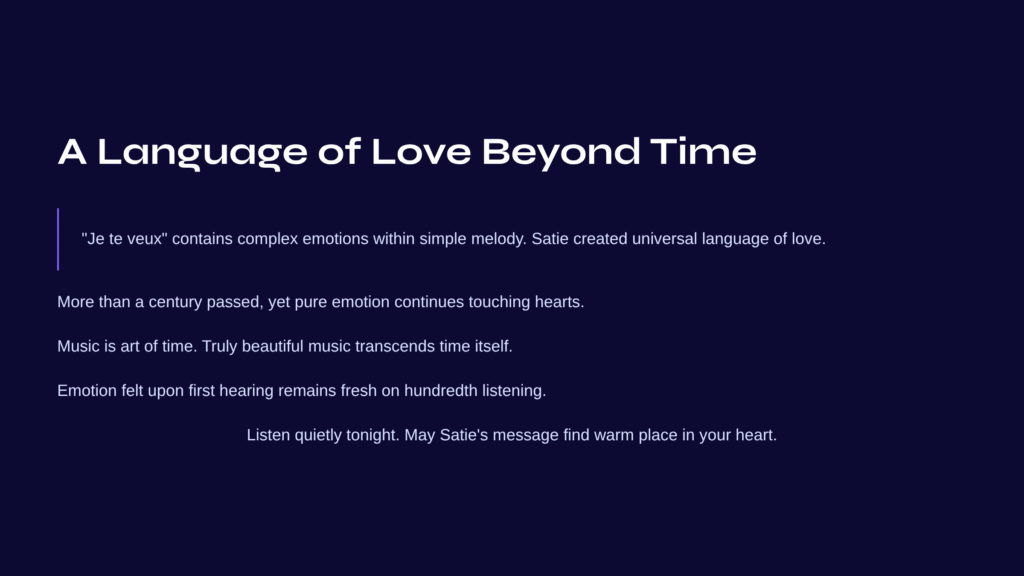
Conclusion – A Language of Love Beyond Time
“Je te veux” is a work that contains complex emotions within simple melody. Through this brief piece, Satie created a universal language of love. Though more than a century has passed, the pure emotion this piece conveys continues to touch our hearts.
Music is ultimately an art of time. Yet truly beautiful music transcends time itself. Satie’s “Je te veux” is precisely such a piece. The emotion felt upon first hearing remains fresh and vivid even on the hundredth listening.
I hope you too will listen quietly to this piece tonight. And may Satie’s small message of love find a warm place to settle in a corner of your heart.
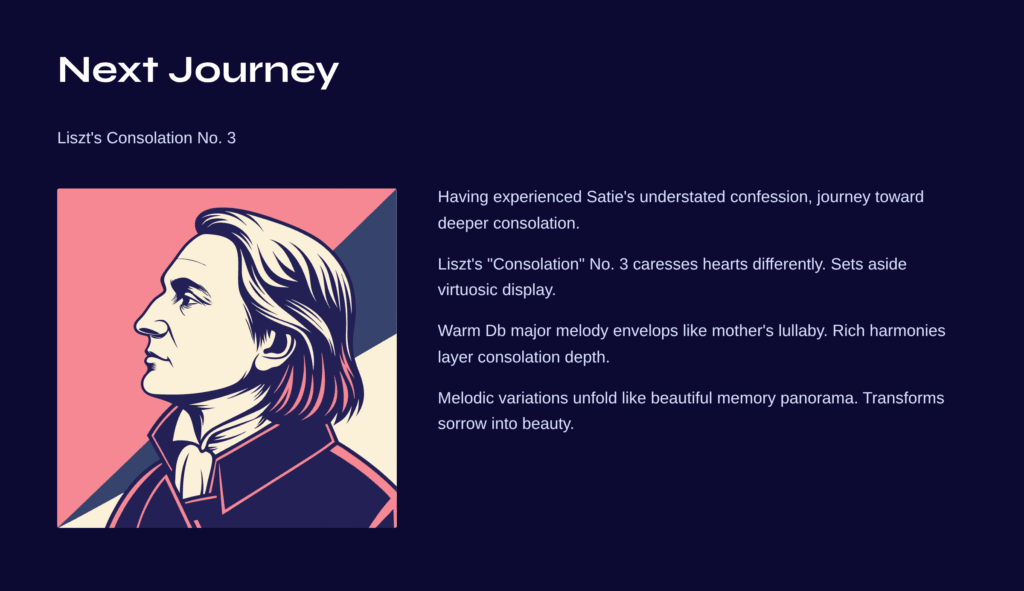
Next Journey – Liszt’s Consolation No. 3
Having experienced Satie’s understated confession, how about journeying toward deeper consolation? Franz Liszt’s “Consolation” No. 3 caresses our hearts in yet another way, different from Satie’s approach.
Though Liszt typically evokes images of flashy virtuosic display, in this piece he sets aside all such elements to sing with pure emotion alone. The warm melody in Db major envelops us like a mother’s lullaby. In contrast to Satie’s conciseness, Liszt layers the depth of consolation through rich harmonies and lyrical melodies.
Particularly, the melodic variations flowing from the piece’s middle section unfold like a panorama of beautiful moments from memory. Experience Liszt’s unique magic – not healing sorrow, but transforming even sorrow into beauty.
